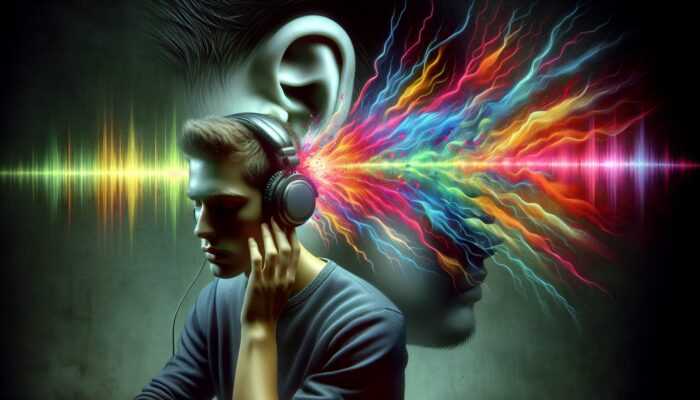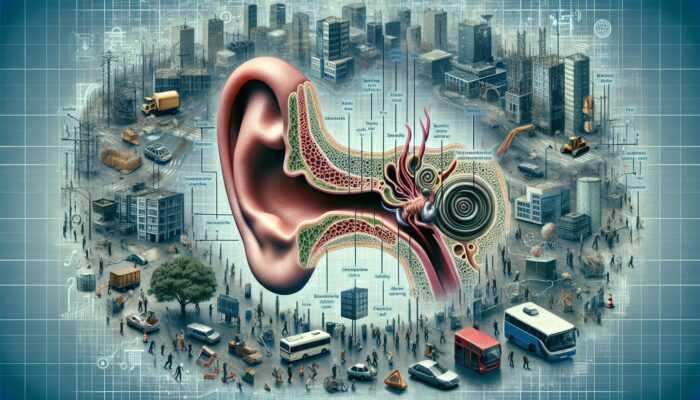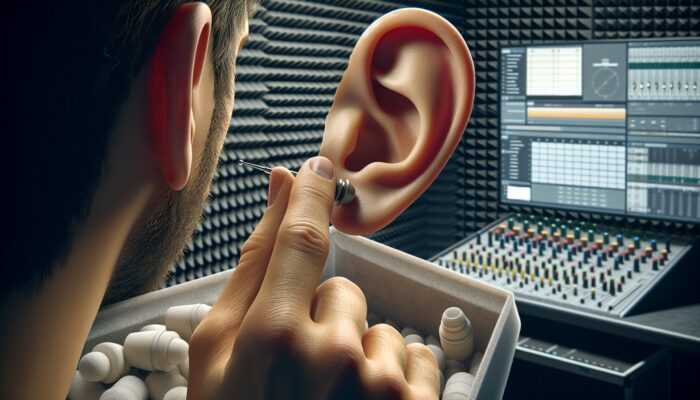Why Ear Health Education Is Essential for Everyone
Essential Knowledge for Maintaining Ear Health
Understanding ear health is vital for everyone, as it equips individuals with the necessary knowledge to maintain their ear health, prevent damage, and identify early signs of hearing loss. This foundational knowledge is crucial across all age groups, given that hearing loss can significantly impact communication, social interactions, and overall quality of life. By learning about the anatomy of the ear, its various functions, and common conditions that may affect it, individuals can foster a sense of responsibility towards their ear health. This awareness empowers people to take proactive measures to protect their hearing throughout their lives, ensuring they remain engaged and connected.
Education surrounding hearing health covers a wide range of topics, including proper ear hygiene, the dangers posed by loud noises, and the importance of seeking medical attention when symptoms arise. The educational framework can be tailored for different age groups, guaranteeing that children, teens, adults, and seniors receive pertinent information. For younger audiences, incorporating fun facts about the ear and engaging activities reinforces their understanding. Meanwhile, adults may benefit from practical advice on managing noise exposure in various environments, while seniors can gain insights into age-related hearing changes and the importance of regular hearing assessments.
Establishing a robust foundation in ear health education enables individuals to better recognize early signs of hearing loss. This knowledge promotes timely intervention, reducing the long-term consequences associated with untreated hearing impairment. Ultimately, a solid grasp of ear health basics is crucial for cultivating a culture of proactive hearing protection across generations, enhancing the quality of life for individuals and communities alike.
How Education Serves as a Preventive Tool Against Hearing Loss
Education plays a significant role in preventing hearing loss by equipping individuals with the skills to protect their ears from noise-induced damage and infections. This proactive approach can save countless individuals from the detrimental effects of hearing impairment, which affects millions worldwide. Through comprehensive ear health education, people learn the importance of using hearing protection in loud environments, practicing safe listening habits when using personal audio devices, and understanding the risks associated with certain medications that can negatively impact hearing.
Preventive education emphasizes the necessity for individuals to recognize risks present in their daily lives. For instance, workers in construction, music, or manufacturing industries are often exposed to hazardous noise levels. By equipping them with knowledge on when and how to use hearing protection, such as earplugs or earmuffs, the risk of developing noise-induced hearing loss diminishes significantly. Similarly, the general public can greatly benefit from educational campaigns that promote safe listening practices—encouraging people to keep volume levels lower and take breaks during prolonged exposure to loud sounds.
Furthermore, education enhances awareness of the signs of ear infections and promotes early treatment, which is essential in preventing potential hearing loss. By learning about what constitutes a healthy ear and recognizing symptoms such as pain, fluid drainage, or persistent ringing in the ears, individuals can seek medical advice promptly. This proactive approach fosters a sense of accountability, empowering people to make informed decisions that safeguard their hearing for years to come.
Why Early Education on Ear Health Yields Long-Term Advantages
Early education about ear health can instill lifelong habits that protect hearing abilities. By instilling these practices at a young age, individuals can maintain their hearing health well into their later years. The long-term benefits of early ear health education are numerous and impactful, including:
- Healthy Habits: Children who learn about ear health early are more likely to adopt protective behaviors, such as using earplugs in noisy environments.
- Self-Advocacy: Educated individuals are better equipped to advocate for their own hearing health and seek help when needed.
- Reduced Hearing Loss Rates: Communities implementing ear health education show lower rates of hearing impairment among their populations.
- Improved Quality of Life: Maintaining good hearing health enhances communication, social interaction, and overall well-being.
- Awareness of Resources: Early education teaches individuals about available resources, such as audiology services and support groups.
- Intergenerational Knowledge Transfer: Educated individuals can share their knowledge with family and friends, fostering a culture of awareness.
- Economic Benefits: Preventing hearing loss can reduce healthcare costs and improve productivity, resulting in economic benefits for individuals and communities.
Implementing comprehensive ear health education from an early age contributes to healthier populations that prioritize preventive care and seek timely interventions when issues arise. By fostering an understanding of ear health that spans generations, we can create a more aware and proactive society equipped to preserve hearing for future generations.
Expert Perspectives on the Value of Ear Health Education in Hearing Preservation
Insight from Experts on the Impact of Educational Initiatives
Experts concur that education significantly influences hearing health outcomes. Understanding the science behind hearing loss empowers individuals to make informed decisions to protect their ears. Research indicates that those who receive ear health education are more likely to engage in preventive behaviors, such as using protective devices in noisy environments and seeking medical advice when experiencing symptoms of hearing issues.
Educational programs often incorporate evidence-based learning components, helping participants to grasp the mechanics of hearing loss and the factors that contribute to it. For example, awareness of the relationship between exposure to high decibel levels and damage to the inner ear structures underscores the necessity of using hearing protection. Furthermore, experts advocate for tailored educational approaches, where information is delivered in formats that resonate with different demographic groups. This level of customization ensures that the material is not only informative but also engaging.
The impact of education extends beyond individual awareness; it shapes community attitudes towards hearing health. When communities prioritize ear health education, they cultivate an environment that encourages individuals to view hearing as an essential aspect of overall well-being. Such a cultural shift can lead to widespread acceptance of preventive measures, regular hearing check-ups, and a commitment to lifelong learning about ear health.
Successful Examples of Ear Health Education Programs
Effective ear health education programs have demonstrated measurable improvements in hearing health, serving as models for successful educational strategies. One notable example is the “Hear Well, Stay Well” initiative launched in the United Kingdom, which focuses on raising awareness about noise-induced hearing loss in young people. Through interactive workshops and engaging multimedia content, this program has seen significant increases in the number of young individuals adopting safe listening habits.
Another successful initiative is the “Sound and Safe” campaign in Australia, which educates outdoor workers and festival-goers about the dangers of noise exposure. The program provides free ear protection and emphasizes the importance of regular hearing checks. As a result, participating communities have reported decreased rates of noise-induced hearing loss, showcasing the impact of targeted education on hearing health outcomes.
In the United States, the “Hear the World” initiative has united audiologists and educators to develop resources that promote ear health in schools. This program has effectively integrated ear health topics into school curriculums, leading to heightened awareness among students and their families regarding the significance of protecting their hearing in daily life.
These examples illustrate that successful ear health education can lead to tangible improvements in hearing health. By learning from these initiatives, other communities worldwide can adopt similar strategies, tailoring their programs to meet the unique needs of their populations and cultural contexts.
Steps to Effectively Implement Ear Health Education
Implementing ear health education requires strategic planning and resources. The following actionable steps can ensure these programs are effective and reach a wide audience:
1. Assess Community Needs: Conduct surveys and research to identify the specific ear health education needs of the community. Understand demographics, cultural contexts, and prevalent hearing issues to tailor the program effectively.
2. Develop Collaborative Partnerships: Collaborate with local health organizations, schools, and community leaders to pool resources and expertise. Partnerships can enhance the program’s credibility and reach.
3. Create Engaging Educational Materials: Develop comprehensive educational materials that are easy to understand and engaging. Use visuals, infographics, and interactive content to facilitate learning.
4. Utilize Technology: Leverage digital platforms to disseminate educational content widely. Online resources, mobile applications, and social media can help reach diverse populations.
5. Train Community Educators: Train educators and healthcare providers to deliver ear health education effectively. Ensuring that those who communicate the information are knowledgeable and passionate is crucial for success.
6. Implement Feedback Mechanisms: Establish systems for collecting feedback from participants. This information can be invaluable for assessing the effectiveness of the program and making necessary adjustments.
7. Evaluate Impact Regularly: Conduct regular evaluations to measure the program’s impact on community awareness and hearing health outcomes. Use data to refine and improve the program over time.
By following these steps, communities can create comprehensive ear health education programs that empower individuals to take charge of their hearing health. The collaboration between educators, healthcare professionals, and community members will foster a culture of awareness and protection that benefits everyone.
How Early Education Can Prevent Hearing Loss
Early education plays a crucial role in preventing hearing loss, as experts emphasize the need for programs targeting young children to foster lifelong hearing protection habits. Children are particularly vulnerable to noise-induced hearing loss due to their developing auditory systems and exposure to loud environments—whether through music, video games, or social activities. Implementing ear health education in schools can significantly reduce the risk of hearing impairment later in life.
Educational programs for young children can incorporate fun activities that teach them about ear anatomy, the importance of listening at safe volumes, and how to protect their ears in noisy situations. By instilling these habits early on, children are more likely to carry these practices into adulthood. Schools can introduce interactive lessons, such as workshops where children can safely experience loud noises and understand the need for protection.
Moreover, parents play a pivotal role in reinforcing the principles of ear health education at home. Parents who are educated about ear health can model protective behaviors, such as using ear protection during noisy home renovations or encouraging safe listening practices with personal audio devices. This creates a supportive environment where children feel empowered to prioritize their ear health.
Experts advocate for integrating ear health education into existing health curriculums, ensuring that every child receives the necessary knowledge to protect their hearing. By prioritizing early education, communities can significantly reduce the prevalence of hearing loss and promote a culture of awareness that lasts a lifetime.
Overcoming Challenges in Ear Health Education
Implementing effective ear health education faces various challenges. Common obstacles include a lack of awareness about the importance of ear health, limited resources for educational initiatives, and difficulties in reaching diverse populations. Experts outline these challenges and propose solutions to ensure successful program execution.
One significant challenge is overcoming the general lack of awareness about hearing health. Many people do not recognize the importance of protecting their ears until they experience hearing loss. To combat this, communities can launch awareness campaigns highlighting the risks associated with noise exposure and the benefits of early education. Engaging local influencers and utilizing social media platforms can help amplify these messages and reach a broader audience.
Resource limitations can also hinder the implementation of ear health education programs. To address this, communities can seek partnerships with local health organizations, educational institutions, and businesses to secure funding and support. Collaborative efforts can help pool resources and expertise, making it easier to develop comprehensive educational initiatives.
Cultural and language barriers present additional challenges in delivering effective ear health education. Tailoring programs to specific cultural contexts and providing materials in multiple languages can enhance accessibility. Engaging local community leaders to assist in program development can also foster trust and encourage participation among diverse populations.
By identifying these challenges and implementing targeted solutions, communities can overcome barriers to effective ear health education. The goal is to create inclusive, engaging, and impactful programs that empower individuals to prioritize their hearing health.
Identifying Common Causes of Hearing Loss
The Impact of Noise-Induced Hearing Loss
Exposure to loud noises, whether from work, leisure activities, or environmental sources, is a leading cause of hearing loss. Education can teach individuals how to protect their ears from such damage. The most effective ways to prevent noise-induced hearing loss include using hearing protection, minimizing exposure time to loud sounds, and regularly checking the volume levels of personal audio devices.
Wearing hearing protection such as earplugs or earmuffs is essential for anyone exposed to loud environments—be it construction sites, concerts, or noisy machinery. Individuals must be educated about the appropriate types of hearing protection available for various situations. For instance, musicians may benefit from specialized earplugs that reduce volume without distorting sound, while factory workers may require heavier-duty earmuffs.
Another crucial preventive measure is to limit the duration of exposure to loud sounds, adopting the “60/60 rule” for personal audio devices—listening at no more than 60% of maximum volume for no longer than 60 minutes at a time. This strategy helps to reduce the risk of permanent damage while still allowing individuals to enjoy their favorite music or podcasts.
Regular hearing assessments are vital, especially for individuals at higher risk of noise-induced hearing loss. Early detection can lead to timely interventions and management strategies, ultimately safeguarding hearing health. By spreading awareness about these preventive measures, education can significantly reduce the incidence of noise-induced hearing loss globally.
Understanding Age-Related Hearing Loss
As individuals age, their hearing naturally declines. However, education can help mitigate this decline by encouraging regular check-ups and early interventions. Understanding that age-related hearing loss is a common condition can help reduce stigma and promote proactive health-seeking behaviors among seniors.
Educational programs targeting older adults should focus on the importance of regular hearing screenings, which can detect age-related hearing loss early. By normalizing these screenings as part of routine healthcare, seniors will be more likely to seek help when they experience changes in their hearing abilities. Furthermore, educational initiatives should emphasize the benefits of timely interventions, such as hearing aids or assistive listening devices, which can significantly enhance quality of life.
In addition to screenings, educational resources about communication strategies can empower seniors to adapt to hearing changes effectively. Simple techniques, such as maintaining eye contact during conversations and minimizing background noise, can make a significant difference in daily interactions. Furthermore, including family members in educational initiatives can foster understanding and support, making it easier for seniors to navigate their hearing health journey.
By prioritizing education around age-related hearing loss, communities can promote a culture of awareness and support that encourages older adults to seek the help they need. As a result, many individuals can maintain their hearing health and improve their overall quality of life.
Infections and Diseases Impacting Hearing
Ear infections and certain diseases can lead to hearing loss if not treated promptly. Education about symptoms and treatments can prevent long-term damage. Common causes of ear infections and diseases include otitis media, swimmer’s ear, and systemic illnesses such as measles or meningitis.
Otitis media, for instance, is particularly prevalent among children and can lead to temporary or permanent hearing loss if not addressed. Educational initiatives can inform parents about the signs of ear infections—such as ear pain, irritability, or fluid drainage—which prompt timely medical attention. By raising awareness about the importance of early diagnosis and treatment, communities can significantly reduce the risk of complications associated with recurring ear infections.
Swimmer’s ear, or otitis externa, is another example where education can play a role in prevention. Teaching individuals about proper ear hygiene, such as drying ears thoroughly after swimming and avoiding inserting objects into the ear canal, can help minimize the risk of this painful condition.
Moreover, education about systemic illnesses that can affect ear health is crucial. Vaccination programs and public health campaigns aimed at preventing diseases like measles and meningitis can significantly reduce the incidence of hearing loss associated with these conditions. By equipping communities with knowledge about infections and diseases that can impact hearing, we create a proactive approach to ear health that leads to healthier populations.
- Otitis Media: Middle ear infection that can lead to hearing loss if untreated.
- Swimmer’s Ear: Infection of the outer ear canal, often caused by moisture retention.
- Meningitis: Inflammation of the protective membranes around the brain and spinal cord, which can affect hearing.
- Measles: A viral infection that can lead to complications, including hearing loss.
How to Make Ear Health Education More Accessible
Leveraging Technology for Ear Health Education
Technology can make ear health education more accessible through online resources, apps, and virtual workshops. This approach effectively reaches a wider audience, especially in areas where traditional education methods may be limited. Digital platforms can provide interactive content, engaging videos, and informative articles that allow learners to explore ear health topics at their own pace.
Mobile applications focused on ear health can offer personalized experiences, including hearing tests, educational materials, and reminders for regular check-ups. These apps can help individuals track their hearing health and identify potential issues early. For example, some apps provide users with tools for monitoring their exposure to loud sounds, empowering them to make safer listening choices.
Virtual workshops and webinars can also facilitate access to ear health education. By leveraging video conferencing technology, experts can reach audiences across the globe, regardless of geographical constraints. Participants can engage with professionals, ask questions, and share experiences in real time, creating an interactive learning environment that fosters community.
Additionally, social media platforms can be harnessed to share bite-sized ear health information and promote awareness campaigns. By using engaging visuals and relatable language, organizations can capture the attention of diverse populations and encourage them to prioritize their hearing health. Ultimately, by utilizing technology effectively, ear health education can become more accessible, engaging, and impactful.
Community-Based Education Initiatives
Community programs can provide hands-on education and support for ear health. These initiatives can be tailored to meet the specific needs of different populations, ensuring that individuals receive relevant information and resources. By establishing local partnerships with schools, healthcare providers, and community organizations, ear health education can become rooted in the community’s framework.
Workshops and health fairs can serve as excellent platforms for disseminating information about ear health. These events can include interactive demonstrations, free hearing screenings, and educational materials that promote awareness about the importance of protecting hearing. By engaging community members directly, these programs can foster a sense of ownership over their ear health and encourage proactive behaviors.
Another effective strategy is to train community advocates or peer educators who can disseminate ear health knowledge to their networks. Equipping these individuals with the necessary resources and information transforms them into champions of ear health, helping to create a supportive environment where knowledge is shared and reinforced.
Tailoring community-based programs to address the specific cultural and linguistic needs of the population is critical for maximizing impact. Utilizing local languages, cultural references, and relatable scenarios can enhance understanding and engagement, ultimately leading to better health outcomes.
Building Partnerships with Health Organizations
Collaborating with health organizations can amplify the reach and effectiveness of ear health education. These partnerships can provide resources and expertise to enhance educational efforts. Health organizations often possess extensive networks and experience in public health initiatives, making them ideal allies in promoting ear health.
By working with established organizations, communities can gain access to funding, training, and educational materials that may otherwise be unavailable. For instance, partnerships with local hospitals or audiology clinics can facilitate free hearing screenings as part of ear health education programs, encouraging individuals to seek medical advice when needed.
Moreover, these collaborations can help develop culturally relevant educational materials and outreach strategies. Health organizations often have insights into the specific needs and challenges faced by diverse populations, allowing for the creation of tailored programs that resonate with different communities.
Regular communication and collaboration among partners are key to ensuring the success of education initiatives. By sharing best practices and evaluating the effectiveness of strategies, partners can continuously refine and improve ear health education efforts, ultimately leading to a healthier population.
Creating Inclusive Educational Materials
Creating materials in multiple languages and formats can ensure ear health education is accessible to diverse populations, including those with disabilities. Inclusive educational resources are vital for reaching individuals who may otherwise be overlooked in traditional educational initiatives.
When developing materials, consider language diversity within the community. Providing translations in the primary languages spoken can significantly enhance understanding and engagement. Additionally, utilizing simple language and avoiding technical jargon ensures that information is accessible to individuals with varying literacy levels.
Incorporating visual elements, such as infographics and videos, can further enhance the effectiveness of educational materials. These resources can convey complex concepts in easily digestible formats, accommodating different learning styles. For individuals with hearing impairments, adding captions or sign language interpretation to video content can facilitate inclusion.
Furthermore, considering the needs of individuals with disabilities when creating educational materials is essential. Providing resources in various formats, such as Braille or audio recordings, can ensure that everyone has equal access to ear health education. Community feedback is invaluable in identifying gaps and opportunities for improvement, helping to create a truly inclusive educational approach.
By prioritizing accessibility in educational materials, communities can foster a culture of awareness and empowerment that supports all individuals in prioritizing their ear health.
What Are the Barriers to Effective Ear Health Education?
Challenges of Awareness and Resource Availability
Many individuals remain unaware of the importance of ear health, and resources for education may be limited. Overcoming these barriers is essential for effective education. To increase awareness about ear health, communities can initiate campaigns that highlight the relevance of protecting hearing and the consequences of neglecting ear health.
Public health initiatives can focus on engaging local media, social media platforms, and community events to spread the message. By making ear health a prominent topic of discussion, communities can foster a culture of awareness. Workshops, informational sessions, and distribution of educational materials can serve as effective tools for reaching diverse audiences.
Resource limitations often hinder the implementation of ear health education programs. Communities can address this challenge by seeking partnerships with local health organizations, educational institutions, and businesses to pool resources and provide support. Collaborative efforts can enable communities to develop comprehensive programs that offer workshops, informational sessions, and materials that promote ear health.
Creating a dedicated ear health education task force can further enhance efforts to overcome barriers. This group can be responsible for assessing community needs, developing educational initiatives, and identifying potential funding sources. By prioritizing awareness and resource allocation, communities can significantly improve their ear health education efforts.
Addressing Cultural and Language Barriers
Cultural beliefs and language barriers can hinder the effectiveness of ear health education. Tailoring programs to address these challenges is crucial for maximizing outreach. Understanding cultural perspectives on health and well-being can inform how ear health education is delivered and received in diverse communities.
Engaging local community leaders and cultural representatives in the development of educational programs can bridge cultural gaps and ensure that initiatives resonate with the target audience. By incorporating culturally relevant examples and practices, communities can foster a sense of ownership and empowerment among participants.
Language barriers can also impede understanding and engagement in ear health education. Providing materials and resources in the primary languages spoken within the community is essential for promoting inclusivity. Utilizing clear and straightforward language while avoiding technical jargon can help enhance comprehension.
Additionally, addressing cultural beliefs surrounding health can encourage individuals to prioritize their ear health. Educational initiatives should acknowledge and respect cultural perspectives while providing evidence-based information about the importance of hearing health. By fostering an inclusive and respectful dialogue, communities can enhance the effectiveness of ear health education efforts.
Combatting Misinformation and Myths
Misinformation and myths about ear health can undermine educational efforts. Dispelling these myths through accurate information is vital to promoting awareness. Common misconceptions often lead to neglect of ear health and prevent individuals from seeking necessary care.
- Myth 1: Hearing loss is only a problem for older adults. Many young people experience hearing loss due to noise exposure.
- Myth 2: Earwax should always be removed. A healthy amount of earwax protects the ear canal.
- Myth 3: Hearing aids are only for the elderly. Hearing aids can benefit individuals of all ages with hearing loss.
- Myth 4: Loud music is not harmful if you take breaks. Prolonged exposure, even at lower volumes, can still damage hearing.
Education initiatives should focus on addressing these myths through clear, factual information. Engaging community members in discussions about ear health can also help clarify misconceptions and promote understanding. By creating a supportive environment for questions and dialogue, communities can foster a culture of awareness, ultimately leading to better ear health outcomes.
Evidence-Based Benefits of Ear Health Education in Preventing Hearing Loss
Research Findings on Educational Interventions
Research shows that educational interventions can significantly improve hearing health outcomes. Studies highlight the importance of ongoing education and awareness campaigns that address both prevention and management strategies for hearing loss. For instance, studies have demonstrated that individuals exposed to comprehensive ear health education are more likely to engage in protective behaviors, such as wearing hearing protection and scheduling regular hearing tests.
Educational interventions that incorporate community involvement have proven particularly effective. When community members actively participate in educational campaigns, they are more likely to adopt the recommended practices. Engaging local leaders and influencers can elevate awareness about hearing health, making it a community priority.
Ongoing education is crucial, as hearing health is not a one-time concern but rather a lifelong commitment. Longitudinal studies indicate that individuals who receive continuous education about ear health are more likely to maintain protective behaviors and seek timely medical intervention when necessary. By understanding the significance of ongoing education, communities can prioritize resources toward developing and sustaining effective ear health education programs.
The Public Health Impact of Ear Health Education
Ear health education contributes to overall public health by reducing the incidence of hearing loss and related conditions. This impact is well-documented in research, demonstrating that communities that prioritize ear health education experience lower rates of hearing impairment.
A strong correlation exists between public health initiatives focused on ear health and improved quality of life among community members. Reduced hearing loss leads to enhanced communication, better mental health, and increased social engagement—all fundamental components of a thriving society. Additionally, communities with robust ear health education programs often see a decline in associated conditions, such as mental health issues and social isolation, which can stem from untreated hearing loss.
Public health campaigns focusing on ear health can benefit from collaboration with audiology professionals and healthcare organizations. By leveraging expertise and resources, these initiatives can create comprehensive strategies that address ear health education, screening, and treatment options.
Investing in ear health education presents an opportunity for significant public health improvements, ultimately contributing to healthier, more engaged communities worldwide.
Economic Advantages of Preventing Hearing Loss
Preventing hearing loss through education can lead to significant economic benefits by reducing healthcare costs and improving quality of life. The financial implications of untreated hearing loss can be staggering, affecting not only individuals but also families and society as a whole.
Education that promotes hearing protection and early intervention can reduce the long-term costs associated with hearing loss. For instance, individuals who actively engage in preventative measures are less likely to require expensive treatments, such as hearing aids or surgical interventions. Furthermore, communities that invest in ear health education can decrease the burden on healthcare systems by reducing the prevalence of hearing-related complications.
Real-world examples of economic benefits from ear health education are evident in various communities. For example, organizations that provide hearing conservation programs for workers in high-risk industries have reported lower healthcare costs and increased productivity. Similarly, schools that incorporate ear health education into their curriculums have noted improved academic performance and social interactions among students who prioritize their hearing health.
Ultimately, investing in ear health education not only enhances individual well-being but also fosters economic growth and stability across communities. By prioritizing prevention and education, societies can reap the rewards of improved hearing health while reducing the financial burden associated with hearing loss.
Effective Strategies for Promoting Ear Health Education
Customizing Education for Different Age Groups
Effective ear health education must be tailored to different age groups to ensure it is relevant and engaging. By adapting educational content for children, adults, and seniors, communities can maximize its impact and promote lifelong healthy habits.
For children, interactive learning methods are essential. Engaging activities, games, and visual aids can help children understand the importance of ear health in a fun and memorable way. This age group benefits from simple, clear explanations about why they should protect their ears and how to do so. Incorporating storytelling or relatable scenarios can make the message more impactful, encouraging children to internalize ear health principles.
Adults may require more detailed information about the implications of hearing loss and preventive measures. Educational workshops and seminars can focus on workplace safety, safe listening practices, and the importance of regular hearing screenings. Real-world examples and testimonials can resonate with adult audiences and highlight the necessity of proactive ear health management.
For seniors, education should emphasize the importance of regular check-ups, as well as strategies for adapting to age-related hearing changes. Group discussions and peer support programs can facilitate sharing experiences and coping strategies. By fostering a supportive community, seniors can feel empowered to address their hearing health proactively.
By tailoring education strategies for different age groups, communities can create a comprehensive ear health education framework that resonates with individuals at various life stages, ultimately promoting better hearing health for all.
Integrating Interactive Learning Approaches
Interactive learning methods, such as workshops and simulations, can enhance the effectiveness of ear health education. These methods engage participants and reinforce learning, leading to better retention of information. By incorporating hands-on experiences, individuals can connect theoretical knowledge with practical applications, fostering a deeper understanding of ear health.
Workshops can include activities that simulate noisy environments, allowing participants to experience the impact of loud sounds on their hearing. By using sound level meters, attendees can visualize decibel levels and understand the importance of protective measures. Such experiential learning creates memorable experiences that resonate with participants, making them more likely to adopt safe listening behaviors.
Incorporating technology into interactive learning can further enhance engagement. Virtual reality (VR) tools can provide immersive experiences that illustrate the effects of noise exposure on the auditory system. This innovative approach not only captivates participants but also reinforces the importance of protecting hearing in relatable scenarios.
Utilizing group discussions and peer learning can also facilitate engagement in educational settings. Encouraging participants to share their experiences and insights promotes a sense of community and support. By fostering connections among individuals, ear health education becomes more relatable and impactful, ultimately leading to positive behavior changes.
Commitment to Continuous Education and Reinforcement
Continuous education and regular reinforcement of ear health practices are essential for long-term success. This ongoing approach ensures that individuals maintain healthy habits and stay informed about best practices for protecting their hearing. Education should not be viewed as a one-time event but rather as a lifelong journey that evolves with advancements in research and technology.
Communities can implement periodic refresher courses, workshops, or webinars to reinforce the importance of ear health and keep individuals informed about updates in the field. Such initiatives can include expert speakers, interactive activities, and sharing of new research findings, ensuring that participants remain engaged and motivated to prioritize their ear health.
Involving family members and caregivers in educational efforts can enhance the impact of continuous learning. By equipping the support network with knowledge about ear health, individuals are more likely to receive encouragement and reinforcement to engage in protective behaviors. This collaborative approach fosters a culture of accountability that promotes better ear health outcomes.
Moreover, utilizing digital platforms for ongoing education can ensure access to resources anytime, anywhere. Online forums, newsletters, and social media groups can keep communities informed and engaged, allowing for discussions and sharing of information related to ear health. By prioritizing continuous education, communities can foster a culture of awareness and proactive management of hearing health.
What Are the Early Signs of Hearing Loss?
Recognizing Initial Symptoms
Identifying early symptoms of hearing loss, such as difficulty understanding speech or ringing in the ears, can lead to timely interventions. Education helps individuals recognize these signs, empowering them to seek medical advice promptly. Early detection is crucial for preventing further deterioration of hearing abilities and addressing underlying issues effectively.
Individuals should be aware of common symptoms that may indicate hearing loss. Some early signs include frequently asking others to repeat themselves, difficulty following conversations in noisy environments, or feeling as though people are mumbling. Additionally, ringing or buzzing in the ears, known as tinnitus, can also be an indicator of hearing problems.
By educating people about these signs, communities can promote proactive health-seeking behavior. Understanding that early intervention can lead to improved outcomes encourages individuals to prioritize regular hearing assessments and seek assistance when needed.
Community programs can distribute informational materials highlighting these symptoms, offering visual aids and relatable scenarios to enhance understanding. Engaging local healthcare providers in these initiatives can create a supportive environment where individuals feel comfortable discussing their hearing health concerns.
Ultimately, early recognition of hearing loss symptoms serves as a foundation for timely intervention and management, reducing the long-term consequences associated with untreated hearing impairment.
When Is It Time to Consult a Professional?
Knowing when to seek professional help for hearing issues is crucial. Education can guide individuals on the appropriate times to consult with healthcare providers. Recognizing the signs of hearing loss is the first step, but understanding when to take action is equally important.
If individuals experience persistent difficulty understanding speech, ringing in the ears, or any other concerning symptoms, it is advisable to schedule a hearing evaluation. Additionally, individuals who notice a sudden change in their hearing abilities should seek immediate medical attention, as this could indicate an underlying issue requiring prompt intervention.
Education should also emphasize the importance of regular hearing screenings, especially for individuals at higher risk of hearing loss, such as those with a family history of hearing impairment or those exposed to loud environments. By normalizing routine hearing assessments, communities can encourage individuals to prioritize their hearing health and address potential issues before they escalate.
Creating a supportive environment where individuals feel comfortable discussing their hearing concerns is essential. Community programs can facilitate conversations about hearing health, ensuring that people know they are not alone in their experiences. Encouraging open dialogue fosters a culture where seeking professional help is viewed as a proactive decision, ultimately benefiting overall hearing health.
Why Regular Hearing Tests Matter
Regular hearing tests can detect issues before they become severe. Education encourages individuals to prioritize these tests as part of their health routine. Just as annual check-ups are essential for overall health, regular hearing assessments play a significant role in preserving hearing abilities.
The frequency of hearing tests may vary depending on individual risk factors, such as age, profession, and family history. For general recommendations, adults should undergo hearing evaluations at least once every 10 years until age 50, and then every 3 years thereafter. Older adults, especially those over 65, should consider annual assessments to monitor any age-related changes in hearing.
Communities can promote awareness of the importance of regular hearing tests through educational campaigns and outreach programs. Highlighting the benefits of early detection, such as improved communication and quality of life, can motivate individuals to prioritize hearing health.
Additionally, collaborating with local healthcare providers can facilitate accessible hearing screenings in community settings. Offering free or low-cost screenings can encourage participation and help to identify individuals who may not otherwise pursue hearing evaluations.
By normalizing regular hearing tests and integrating them into health routines, communities can foster a culture of proactive ear health management, ultimately leading to better hearing outcomes for individuals of all ages.
Proven Strategies for Enhancing Ear Health Education
Developing Comprehensive Educational Resources
Comprehensive educational materials are essential for effective ear health education. These resources should be accurate, accessible, and engaging to maximize their impact. When developing educational content, it is critical to consider the target audience’s needs and learning preferences.
To create effective educational materials, begin by conducting research to understand the specific ear health concerns within the community. This information will guide the content’s focus and ensure that it resonates with the audience. Utilize clear language, relatable examples, and visuals to engage readers and enhance comprehension.
Incorporating diverse formats into educational materials can also improve accessibility. Combining text-based resources with videos, infographics, and interactive tools can cater to various learning styles and increase engagement. For instance, short video clips demonstrating safe listening practices or ear hygiene can complement written materials and provide added value.
Additionally, collaborating with healthcare professionals and audiologists during the development process ensures that the information is accurate and evidence-based. Their expertise can enhance the credibility of the materials, fostering trust among community members. Regularly updating educational resources to reflect the latest research and practices is vital for maintaining relevance and effectiveness.
By prioritizing the development of comprehensive and engaging educational materials, communities can create impactful ear health education initiatives that empower individuals to take charge of their hearing health.
Training Educators and Healthcare Professionals
Training educators and healthcare providers in ear health education ensures that the information delivered is accurate and effective. This training can enhance the overall quality of education, creating a knowledgeable support network that fosters awareness and proactive behaviors.
Workshops and training sessions can be organized to equip educators and healthcare providers with the necessary tools and resources to teach ear health effectively. Topics may include the anatomy of the ear, common causes of hearing loss, and strategies for prevention. Providing real-world case studies and practical applications can enhance understanding and facilitate the dissemination of information.
Involving local audiologists as trainers can further enrich the educational experience. Their expertise can bridge the gap between theoretical knowledge and practical applications, ensuring that participants leave the training with actionable insights. Additionally, creating a resource library for educators and healthcare providers can facilitate ongoing learning and support.
Regular follow-up training sessions can help reinforce knowledge and ensure that educators remain current with advancements in ear health research and education. Encouraging collaboration among educators fosters a sense of community, enabling them to share best practices and innovative ideas for implementing ear health education.
By investing in the training of educators and healthcare providers, communities can create a supportive network that prioritizes ear health education and promotes positive outcomes for individuals of all ages.
Evaluating and Enhancing Educational Programs
Continuous evaluation and improvement of ear health education programs are necessary to ensure their ongoing effectiveness. Feedback and data analysis can guide these improvements, allowing communities to adapt their strategies to meet the evolving needs of participants.
Establishing clear evaluation metrics is essential for measuring the impact of educational programs. These metrics may include participant engagement, knowledge retention, and changes in behavior following program participation. Surveys and feedback forms can be excellent tools for gathering insights from participants about their experiences and suggestions for improvement.
Incorporating community input into the evaluation process fosters a sense of ownership and accountability. Encouraging participants to share their experiences and perspectives helps identify areas for growth and development. Regularly reviewing and analyzing collected data will inform necessary adjustments to educational materials and delivery methods, ensuring they remain relevant and impactful.
Additionally, collaborating with local health organizations can provide valuable support in evaluating program effectiveness. Their expertise in public health research can guide data collection and analysis processes, ensuring that findings are actionable and meaningful.
By prioritizing continuous evaluation and improvement, communities can create dynamic ear health education programs that adapt to the changing needs of individuals, ultimately leading to better hearing health outcomes.
Frequently Asked Questions about Ear Health Education
What does ear health education entail?
Ear health education involves teaching individuals about the anatomy of the ear, common hearing issues, preventive strategies, and the importance of maintaining good ear health throughout their lives.
Why is ear health education crucial?
Ear health education is vital for preventing hearing loss, promoting awareness of ear-related issues, and empowering individuals to take proactive measures to protect their hearing.
What are the common causes of hearing loss?
Common causes of hearing loss include noise exposure, aging, infections, and certain diseases. Education can help individuals understand these risks and implement preventive measures.
How can I safeguard my hearing?
You can protect your hearing by wearing ear protection in loud environments, listening at safe volumes, taking breaks from noise exposure, and seeking regular hearing check-ups.
What are the signs that I may be experiencing hearing loss?
Signs of hearing loss include difficulty understanding speech, frequently asking for repetition, ringing in the ears, and trouble hearing in noisy environments.
How often should I get my hearing checked?
Adults should have their hearing tested every 10 years until age 50, then every 3 years. Seniors should consider annual assessments to monitor age-related changes.
What should I do if I notice symptoms of hearing loss?
If you experience symptoms of hearing loss, such as difficulty understanding speech or ringing in the ears, schedule an appointment with a healthcare provider for a hearing evaluation.
Can children also experience hearing loss?
Yes, children can experience hearing loss, often due to infections or noise exposure. Early education about ear health can help prevent long-term issues.
What role do healthcare providers play in ear health education?
Healthcare providers play a vital role in ear health education by offering screenings, providing accurate information, and encouraging preventive behaviors among patients.
How can I access resources for ear health education?
You can access ear health education resources through community health programs, online platforms, and local healthcare organizations that offer workshops and informational materials.
The post Ear Health Education: A Universal Approach to Protect Hearing appeared first on The Microsuction Ear Wax Removal Network.





















